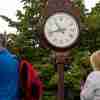Avian flu poses 'significant risk' to Canadian poultry farms as cases reported in multiple provinces
CBC
The highly contagious and deadly avian influenza is spreading among poultry birds in Canada, with government authorities tracking cases in 12 farms so far in Ontario, Nova Scotia and Newfoundland and Labrador, as well as additional possible cases in Alberta and Quebec.
"In Canada, avian influenza is a very serious issue. It creates mortality in birds and prevents the ability of producers to export their flocks," said Craig Price, who is heading up the response to the avian influenza at the Canadian Food Inspection Agency, the federal government body that regulates poultry farming in the country.
"The impact on the Canadian poultry industry is fairly significant, with exports of around $800 million a year to various markets. We see, every time we have an infected premises, the loss of export from those producing areas."
The hardest-hit area right now is in southern Ontario, where cases have been found at six farms. Farms with cases are quarantined, but countless other farms within 10 kilometres have also had strict movement controls placed on them, Price said, disrupting the industry over a large area.
The cases are linked to contact with wild birds, and Price says they may grow as birds migrate north during the spring from the U.S. into Canada. There have been 130 outbreaks in 24 states in the U.S.
A goose, duck, red-tailed hawk and red-breasted merganser have tested positive for the strain in Ontario in recent weeks. The strain was also detected in a Canada goose and two snow geese in Quebec.
Price says based on what's happening in the U.S, the avian flu will likely spread to each province in Canada.
While the impact on birds is severe, it's rare for the current type of avian influenza, H5N1, to infect humans. Samira Mubareka, a physician at Sunnybrook Health Sciences Centre and virologist at the University of Toronto, says vigilance is key to making sure any human cases are caught early.
"There really hasn't been sustained person-to-person transmission and there have been no human cases," she said. "But again, you don't want to miss the first one."
That means in regions that are seeing cases of avian flu, health workers should check if people turning up with flu symptoms have had contact with birds and make sure they're checked for the H5N1 strain.
"I think the most important thing is just to be vigilant, make sure that people are aware of it, so they ask the right questions about exposure," Mubareka said.
The virus may infect a person if they come into very close contact with an infected bird, Mubareka said. But it would likely have to mutate to spread from person to person.
A person can't get infected from eating chicken or other cooked poultry birds. Mubareka said all the standard precautions to handle and cook meat properly were sufficient.
The COVID-19 pandemic could have both positive and negative consequences for tracking the spread of avian influenza. Mubareka said public health systems would probably be more confident in how to react if cases did arise in humans, because of their experience with the COVID-19 pandemic. At the same time, health workers are stretched thin.

Health Minister Adriana LaGrange is alleging the former CEO of Alberta Health Services was unwilling and unable to implement the government's plan to break up the health authority, became "infatuated" with her internal investigation into private surgical contracts and made "incendiary and inaccurate allegations about political intrigue and impropriety" before she was fired in January.












